
![]()
Entrenadora

|
Club de Patinaje LINCES Medellín |
|||||||||||||||||||||||||||
|
Summer 2003 - Vol. 13 No. 2 by Frank J. Fedel, C.E.S. Michigan
Physiologic/Biomechanic/Mental ConsiderationsAt any age, there are a number of areas that combine to create a good athletic performance. Among the most important areas are:
Since these areas include factors that are quite diverse, let’s take a look at the first one; see how each of the factors listed under that area is affected by aging; and find out what we can do to combat the negative effects.
PhysiologyVO2: Oxygen consumptionTypically we as sports scientists look at maximal oxygen consumption (Max VO2) to give an idea of how much work an individual can perform. Maximal oxygen consumption is a measure of the amount of oxygen that an individual can utilize/consume per minute. It is measured in either milliliters of oxygen per kilogram of body mass (ml/kg/min), or in liters of oxygen per minute (l/min). A person with a higher Max VO2 can typically do more work than a person with a lower Max VO2. One of the goals of training is to be able to do more work, and we use Max VO2 as one measure of how effective a training program is for a person. Max VO2 is influenced by a variety of factors, including a person’s physical size, maximum heart rate, stroke volume, blood volume, muscle capillary density, and mitochondrial density. As each of these factors increases, VO2 increases (in the case of increasing physical size, the increase in VO2 is typically seen in only the absolute max VO2 [measured in l/ min], not relative max VO2 [measured in ml/kg/ min]). If you have a basic understanding of oxygen consumption, the effects of changes to the factors listed above should make sense logically, even if you’re not well versed in each term. Simply, if you are able to pump more oxygen-laden blood to the working muscle that is able to use it, your Max VO2 increases. Since age has a negative effect on at least one factor (maximum heart rate - MHR - which typically declines approximately 1 beat-per-minute for each year of advancing age), we can ascertain that maximal oxygen consumption should decrease with age. If MHR was the only factor that changed this would be true, but since the other factors can be changed with training, by increasing them, the change in VO2 brought about by a reduction in MHR can be offset to a large degree, if not completely. Appropriate training can increase a person’s physical size, stroke volume, blood volume, muscle capillary density and mitochondrial density. While one single factor, increasing blood volume through training, contributes largely to improving performance and can be enhanced with as little as one week of training (thereby increasing stroke volume), the other factors contribute as well. So we know that training to improve the other contributors to VO2 can improve our Max VO2, but there is another factor; a potentially more important factor in determining performance. This physiology-based factor in performance is consistently overlooked by athletes, coaches and researchers once they get on the “get a higher Max VO2” bandwagon). This factor is the Lactate Threshold. Remember when I stated that an individual with a higher Max VO2 can typically do more work than a person with a lower Max VO2? I intentionally left that statement open for clarification by using “typically.” In many cases, someone with a higher VO2 will not be able to out-perform a "lower-rater", because, as I love to say, “It ain’t what you got, it’s what you do with it.” This is not simply a bad-grammar excuse that people use to feel better about the fact that they don’t have much; it has its basis in fact. Here's an example: Let’s say that athlete A (Joe) has a Max VO2 of 60 ml/kg/min (60 milliliters oxygen per kilogram of body weight per minute) and athlete B (Mike) has a Max VO2 of 55 ml/kg/min. On the basis of Max VO2 alone, you would suspect that Joe would be able to out-perform Mike because Mike’s VO2 is almost 10% lower than Joe’s. Yet, if Joe’s Lactate Threshold - the point at which lactic acid begins to accumulate as a result of a mismatching of blood flow/oxygen supply to the ability of the mitochondria to do their job (as well as other biochemical adaptations that occur with appropriate training) - is reached at 65% of his Max VO2, and Mike’s Lactate Threshold is reached at 78% of his Max VO2, Joe will be able to work continuously at a VO2 of 39 ml/kg/min (60 ml/kg/ min x 65%), while Mike can work at a VO2 of 42.9 ml/kg/min (55 ml/kg/min x 78%). In effect, Mike can work at a VO2 that is 10% higher than Joe's sustainable VO2. Remember that famous saying, “It ain’t what you got, it’s what you do with it.” Although Joe has a higher Max VO2, his sustainable VO2 is lower due to Mike’s higher Lactate Threshold. Here's another example of the proverbial, "a picture is worth 1,000 words":
Of course, even with a higher sustainable VO2, Mike is not guaranteed success when competing against Joe. There are other factors - biomechanics, efficiency, equipment, strategy, preparation, etc. But all other factors being equal, Mike would have an edge over Joe by virtue of being able to use more of what he has; which he acquired through training. But back to aging. Does Lactate Threshold change with aging? It can; if training intensity and volume are reduced. And given the results of some longitudinal studies on performance (which examined a non-invasive marker of LT), it appears that it can be maintained by sustaining training volume and intensity. What does all of this have to do with being a master athlete? Well, two key components to achieving results in training are consistency and persistence. And guess who is typically consistent and persistent? You guessed it - master athletes. Advancing age can bring with it benefits, a few of which are the character traits of patience, understanding, and focus. These characteristics all lend themselves to being consistent and persistent in training. As a master athlete, when you have a goal, you are more likely to visualize that goal, focus on achieving it, and set a course to attain it now, vs. when you were younger. Of course, this is not universal, but if you consider the responsibilities of a typical master athlete (career, family, maintaining a home, financial responsibility, etc.), you can see how planning to meet the demands of life in general are analogous to planning for the demands of training. And the added bonus of doing something “for yourself” can make training for performance even more rewarding, when you have so many other “heavy” responsibilities. Combat the Aging ProcessSo how do we offset some of the deleterious effects of aging on physiology? Attack each factor individually, then combine the attack plan into a training program. And that is precisely what many master athletes do, without even knowing it. The good news is that there are no “secret” techniques needed to train as you age. (Sorry, folks - it’s still hard work.) But diligent training will get you where you want to go. To improve your Max VO2, you need to follow the basic principles found in any primer on exercise training for your sport - and always keep in mind the activity/muscles used, as well as the time spent in competition as the most basic factors. Specificity of training states that you should train for your sport by performing the sport, or activities which very closely mimic your sport. In the case of inline or ice skating, there are a few activities which closely mimic the movements of the sports -- cycling is one activity; cross-country skiing is another (using the proper technique). Using either of these sports to supplant your training will help relieve boredom, add some variety/excitement, and reduce the chance of overuse injury from skating. In terms of the amount of time spent in competition, keep in mind the cardinal rule: train for your races. If you are a 100 meter sprinter, your training will not be the same as if you are a marathoner. Again, basic physiology or training books will give you examples based on competition times. No matter what anyone says, there is no perfect training schedule that works for everyone, so don’t expect a book to be your coach, but the guidelines that most good training texts (Suzanne Nottingham’s Fitness Inline Skating and Barry Publow’s Speed on Skates) will get you started. Next time, we’ll take a look at some of the more exciting, complicated issues - equipment and efficiency, as well as discuss some ways you can test your fitness level. Summer 2003 - Vol. 13 No. 2 by Frank J. Fedel, C.E.S. Michigan
Part II of this series was supposed to look at equipment and efficiency, two major contributors to performance. But based on the number of requests I've received relative to the first installment of The Masters Skater, we'll instead focus on the topic of Lactate Threshold and how it is related to performance, along with ways to train for improving it. Before we delve in to those areas, let's take a bit of a "refresher course" on the components of athletic performance and how they are altered by the aging process. We are looking at athletic performance in sports such as inline skating, running, and cycling which require muscles to repeatedly exert forces through a range of motion for an extended time (dependent on the distance traversed). In inline skating, the distances are anywhere from a sprint to a marathon. Most of the focus of this series is on the "aerobic distance" races (10K - marathon). RecapThe major contributors to performance in this subset are physiology (VO2, lactate threshold (LT)), biomechanics (efficiency, equipment), and mental considerations (preparation, strategy, tactics). In Part I (physiology) we noted: max VO2 typically declines with age; the decline can be offset to a large degree with proper training; lactate threshold is a significant contributor to performance, since we are only able to use that portion of our max VO2 that is "sustainable" for the duration of a race; and we can pretty much maintain our LT as we age, if we maintain a threshold volume and intensity of training. Now, a bit more about the LT. Tricky Little Thing Called LT
The graph below depicts the results of a typical
LT test. In Part I, we described
two skaters, Joe and Mike. These test results are from our
fictitous skater Mike. Notice how the lactate concentration
increases slowly, then much faster, as the oxygen consumption
increases. At low workload levels, the lactate concentration in
the blood remains fairly low (near 1 - typical resting level).
As workload increases, the lactate concentration increases until,
at a point, it starts to increase in a non-linear fashion (curved
line behind the lactate concentration data points).
Theoretically, this point is your LT.
As you can see, it is not a clearly-defined point, and there is
much controversy in terms of "where" the
LT occurs.
If you look at the dashed line coming in to the graph from the left, it points to this lactate concentration. In addition, the dashed line pointing downward from that lactate concentration data point points to the oxygen consumption level at the LT(in this case, approximately 45 ml/kg/min). Finally, the left-facing, horizontal dashed line that starts at the heart rate directly above the "breakpoint" lactate concentration shows the heart rate at MIke's LT (in this case, 150 beats/min). When calculated as a percentage of a person's max VO2, their LT will typically fall into a range of approx. 60% to 90%. Untrained individuals will, of course, have the lowest values, while many masters athletes will rank near the 80% mark. Some elite athletes can rank even higher; near the 90% mark. Looking at the graph, we can see that Mike's LT occurs at approximately 78% of his max VO2 (42.9 ml/kg/min LT VO2 divided by his 55 ml/kg/min max VO2). Now I Know... So What?Great. Now we know (theoretically) our LT. What do we do with it? It would seem obvious, train at that level. Well, as it happens, athletes do not use 100% of their LT during many races, and in training, it has its place as well. In fact, the percentage of LT that can be sustained varies according to the duration of the event. For example, in a 10K race, you can skate at a level slightly above your LT, while in a marathon, you would need to stay slightly below your LT. In a two to three hour skate race, you'll need to stay at a level comfortably below your LT. But how can you skate above your LT? You learn to deal with the discomfort of skating with an accumulation of lactic acid in your muscles. There are physiological reasons why you cannot skate tremendously above your LT for extended periods of time, but a highly motivated, extremely well-conditioned athlete can sustain a power output representing their max VO2 (a value significantly higher than their LT) for nearly an hour. Longer bouts of exercise carried on at that level would ultimately produce too much lactate to continue exercising without reducing the workload. How to Use the InformationSo you need to keep in mind - once you find out your LT - that you won't be working at that level all of the time. For endurance training, you'll want to train with a heart rate equivalent to some 20 beats or so below your LT heart rate. For speed work, you can train with your heart rate at or near your LT heart rate, and for short bursts, exceed your LTheart rate. Using the example graph above, and the
information from Part I, if Mike had a max vo2 of 55
ml/kg/min and a lactate threshold
that occurred at 42.9 ml/kg/min, his
lactate threshold heart rate ( LTHR)
is 150 beats/min. This represents 78% of his max vo2,
but it represents 83% of his max heart rate (HR) - 180 beats/min
(see Table below). By using this information, Mike could setup a
solid plan for his training. During his initial endurance build-up
phase, he would keep his exercise HR approx. 20 beats/min below
his LTHR and his exercise HR at or
below 130 beats/min. This training HR would represent 72% of his
max HR; a figure consistent with conventional fitness training
information. It would represent 63% of his max vo2,
which is consistent with conventional wisdom. This level of
training would be appropriate for 6-12 weeks of training (during
a base-building period), contingent on the idea that he is
training for distances of 10K or greater. For speed work, he
would achieve and maintain an exercise HR close to 150 beats/min,
and for short bursts, a higher HR.
Of course, all of this is dependent on the LTHR not changing (which, in reality, it does). Since we know the LTHR changes as a result of training (among other things), it is a good idea to have your LTHR re-measured occasionally during training - especially during the first 3 months of your program, where much change is likely to occur. Once a new LTHR has been established, the training principles apply to the new LTHR . Note: HR can be quite variable. Heat, humidity, time of day, ingestion of caffeine or other substances, and others can have a significant effect on your HR; it should be used mainly as a guide. Your perception of your effort level is usually a good indicator of your body's physiologic load - listen to it. While this information is not just for master athletes, it does provide "hope" for the masters athlete who is concerned that their max vo2 and max HR are declining. Numerous masters athletes have increased their LT to a level that they did not previously experience, allowing them to go faster and farther than ever before. In fact, since efficiency (which I promise we'll discuss) can also be enhanced through repeated training, the masters athlete has yet another "leg up" on the younger skater. I promised many of the respondents to the first installment that I would cover LT in this issue, and how to do your own "lab test" of LT in another issue. So, unless anyone has any strong objections, the topics of equipment and efficiency will be pushed back another issue, so we can use Part III to describe how to do a "relative" of an LT test on yourself, and get all of you worked up about how fast you can go. In Part I, three masters endurance athletes were highlighted in order to demonstrate the fact that elite level performances are quite possible once an athlete reaches the "Masters" level age of 30. Just to be fair, here's another world-record performance by a masters athlete - this time, a sprint event athlete. In ‘95, Britain's Linford Christie broke the world indoor record in the 200m. Christie set the mark with a time of 20.25 at the age of 34. Summer 2003 - Vol. 13 No. 2 by Frank J. Fedel, C.E.S. Michigan
In the last installment of The Masters Skater, we demonstrated the fact that an individual's lactate threshold (LT) is a critical factor in limiting (or enhancing) performance. As we mentioned, measurement of LT is usually done in a laboratory equipped to measure heart rate, oxygen consumption lactate and other physiologic variables. Since we all know that lab tests are time consuming, expensive and typically unavailable to most skaters, this installment of The Masters Skater will describe a skate-specific field test designed to help determine a measurement functionally very similar to LT. I developed this test to help you:
Although this test MAY represent your lactate threshold, I prefer to call it a "field test to determine your maximal steady-state skate pace (MSSP)." It's confusingThere are scores of research articles in various physiology journals espousing the intricate nature of LT testing. And there are arguments over the level of blood lactate that can be withstood for extended periods of time - indeed there appears to be a broad range of blood lactate levels within which individual athletes are able to function, so determining blood lactate levels for individual athletes may not be as helpful as initially thought. In addition, debate rages over how useful the determination of LT is for most athletes, since it is an expensive proposition to do the testing required to measure blood lactate, and blood lactate measurement is currently at the very least a minimally invasive procedure (a needle or other lancing instrument is typically used to poke the finger or an earlobe in order to draw a blood sample) with the potential for infection. With so many dissontant positions on lactate testing (all with a basic agreement that LT is a useful parameter), many sports scientists have tried to couple the basics of muscle physiology during exercise with physiologic responses to produce easy-to-use field tests in place of laboratory tests. These field tests - which have been used successfully in a number of sports, including track and field, cycling and swimming - have some very common characteristics which have been incorporated into our skate-specific LT, or MSSP, test. EquipmentIn order to do our MSSP test, you will need the following:
A major key to the test is that it should be
done continuously; you must continue skating for the duration of
the test in order for the results to be valid, reliable and
understandable. Any rest periods that you take between stages (for
any reason including traffic, a sore back or adjusting your
posture) will have an adverse effect on the results. To
demonstrate this point, below are a few "pitfalls" that I ran
into while validating this test. Watch out for them and you'll
save yourself time, as well as reducing the chances of erroneous
or misleading results. I had to perform this test three times before getting "good data." During the first test, there was too much traffic where I was skating, and the draft effect I got from the cars significantly lowered my heart rate during a few trials. The resulting graph didn't make much sense. The message here is that you should make sure you have an unencumbered path on which to skate. That means void of traffic, potholes, stop signs, or anything else that would preclude you from maintaining a consistent pace during 2-minute stages. During the second test, I encountered a constant wind. It wasn't very fast (3 - 5 mph), but even 3 mph is enough to make a difference in the effective wind drag. The presence of wind made skating in one direction much easier (resulting in a falsely-lowered heart rate) and skating in the other direction much more difficult (resulting in a falsely-elevated heart rate). As a result, heart rate readings did not rise consistently; every time I switched directions, the heart rate would either drop precipitously, or climb unrealistically. I decided to wait another day and do the test during a low-traffic period when the wind was not blowing. The resultant graph was extremely helpful, and fairly clearly described my MSSP (see Graph). Based on my current 10K time trial times on inline skates, the test provided me with a valid measure of my MSSP. How the MSSP test worksThe concept behind this test is that your heart
rate and blood lactate levels do not rise in a linear (at the
same rate) fashion during exercise of increasing intensity. As
the workload you encounter becomes increasingly higher, your
lactate level increases, but your heart rate does not increase
at the same rate, or to the same degree.
Your MSSP is the point on a graph of heart rate
vs. speed where there is a fairly clear change in the
relationship of heart rate vs. speed. As you can see in this
graph, the heart rate increases in an almost linear fashion with
speed. Near the top of the graph, when the speed reaches 21 mph,
the heart rate does not increase from thfse previous stage as
much as it did during the previous 1-mph increment (stage). This
non-linear increase in heart rate (the "breakpoint") signifies
my MSSP. Note that the last stage also follows this same pattern
- the heart rate does not increase nearly as much as it did
during the previous stages. Note: The "Predicted Y" line on the graph was generated by doing a statistical analysis of the data in a spreadsheet program. If the heart rate continued to rise at the same rate throughout the test, the heart rate data points would fall exactly on the Predicted Y line. Near the top of the graph, it is clear that the heart rate does not continue to rise at the same rate as it did during the preceding stages. This is a helpful tool in visually locating your MSSP pace; you can clearly see where the deviation from "normal" begins. Before the arguments, disagreements and name-calling ensue, note my initial statement about this test: it is designed to be a field test to determine your Maximal Steady-State Skate Pace, NOT your LT. But for all practical purposes, for most of us (other than skaters on Olympic-level training programs or professional skaters with access to high-level physiology labs) knowing our MSSP should be of more interest than knowing our LT. It provides a measure that we can identify with - how fast we can skate for extended periods. The bottom line is this: knowing your MSSP is important from a functional/training standpoint, since you can do something with that information. Now, on to a few more specifics about how you can insure good results. Included with the tips are some specifics on how I collected the data in the graphs. The tools I used made the test so easy, it was almost TOO simple. KISS (Keep It Simple, Skater!)Try to keep the test as simple as possible. Look for a flat (no inclines and no declines) street with very little traffic and no stop signs. Make sure you know the speed you are skating to within 0.1 mph. Note: if you have someone pace you with a bicycle using a speedometer that reads in "integer" values (12 mph, 13 mph, 14 mph, etc.) instead of more accurate floating-point values (12.8 mph, 12.9 mph, 13.0 mph, etc.), your results can be significantly effected and you can wind up with invalid information - my solution was to use a small, handheld device that constantly updates and displays speed in mph (see description below). To monitor heart rate, use a heart rate monitor that records heart rate in specific time intervals, and can "play back" the results when you are finished. That's all you need - speed and heart rate. Distance is actually not important, since you will be looking at the results of your speed and heart rate values. Helpful TechnologyPacing Device
Heart Rate Monitor
Using the graphing software that comes with PC Coach, I looked at my graph of heart rate vs. speed (time) and immediately had feedback on my tests. The graph made it pretty clear where the breakpoint of heart rate and speed was located. However, I wanted to make the breakpoint clearer, so I entered the data from the PC Coach program into a spreadsheet and did a minor modification to the information to make the graph more consistent-looking. I used the heart rate from only the SECOND minute of each stage as representative of the heart rate produced by each stage. This made the heart rate increases more consistent, since part of the first minute of each stage was spent increasing my skating speed and trying to "settle in" to that speed. Since heart rate doesn't respond instantaneously, eliminating the heart rate information from the first minute of each stage provides "better" data. That's all there is to it! Now that you are armed with a field test, you can test yourself to find your MSSP. And armed with that information, you can develop a training program more optimally suited to your ability and fitness level. We'll address some of the options for using the MSSP results in a training program in future installments of The Masters Skater, but for now... get out there and see how you're doing! Mar. 2001 Issue - Vol. 11 No. 5 The Masters Skater - Part IV High Level Performance by Frank J. Fedel, C.E.S. Michigan
As mentioned in The Masters Skate, Part I, there are three major areas of importance that should be taken into consideration when attempting to achieve high-level performances. The first, Physiology, deals with oxygen consumption, lactate threshold, heart rate and other biologically-related factors discussed in detail in Part I, II and III of this series. The second, Biomechanics, focuses on the study of motion of the human body, and the effects of equipment on performance (equipment has an effect on the motion of the body). The third, Mental, is probably the most difficult to "get a handle on," since it is not measurable by conventional methods, and different aspects of the mental game work better for some than for others. This installment will address two of the Mental contributions which encompass philosophy, mental preparation, motivation, strategy, tactics and more. We'll focus on philosophy and strategy using a recent masters-age personal athletic achievement illustration. The GoalConventional thinking says that it is important to have a goal in order to perform well. This may seem obvious, yet many athletes don't really have a goal. Consider your situation right now; do you have a clearly-defined, written-down goal? If not, why not take a few minutes right now to open up your daytimer (or calendar), and write down at least one goal. It might take a few minutes to come up with something you really want, but without a goal defined, it's not easy to continue on to strategy. Think of a goal you'd like to achieve, and write it down (or remember it exactly as you state it). Whether that goal is specific (I want to finish my next 10K in 17:00 or less) or broadly-defined (my goal is to finish a marathon) is not important at this point; what is important is that you have one. It's a good start. Goals are a way of giving us a direction for our energy and effort. Yet we need to have one clearly defined in order to move towards it optimally. In order to put a 'real-life' story to this concept, here's the illustration: Last year a friend (a longtime training and racing partner) asked me if I wanted to do an Ironman triathlon with him. I was shocked, since he had never expressed an interest in such an event before. And since I have never had even the slightest desire to do a race of that distance, my reply was "Sure, if you want to do one, I'll train with you." I'm sure that if you're reading this article and you're at least somewhat competitive, you can relate to this; there's just something about a challenge that makes it almost irresistable. I don't really know why I agreed to do it, since I was content doing smaller duration (1-2 hour) races, but I agreed. In any event, my answer to him automatically defined two goals for me - a short-term goal: to train at a level adequate to complete a 12-hour race, and a long-term goal: to complete the event. At the time, I was exercising for health, not for competition averaging 3 30- to 45-minute sessions a week. Bumping up training to complete a triathlon was a daunting task, especially since I had 6 months to do it. But again, having a long-term goal was very helpful. It allowed me to determine what needed to be done in order for me to achieve my goal. Depending on your current level of fitness and your outside (non-exercise) commitments, you can adjust your goal accordingly. My goal was not to try to win a triathlon, or even to finish in the top 10 in my age group. Based on a realistic scenario, I wanted to finish it, and not feel like I had been hit by a truck. Being realistic is an important component of goal-setting. Being realistic doesn't mean that you set your sights low; on the contrary, it means that you're taking into account all of the issues with which you're going to have to deal. Consider your commitments with work, marriage, children, home, outside interests, etc. and come up with a realistic, but challenging goal. Take-home MessageIt's a good idea to set a goal. It can be broadly or specifically-defined, but having one is important, and can help direct your training. The StrategyOnce your goal is in place, you need to consider a strategy. The goals I set took into consideration a plethora of day-to-day factors. For example, you wouldn't expect to have much time for your family if your strategy was to leave every Friday night for an all-out training weekend, only to return on Sunday evening, and to also go directly from work to train for 5 hours every evening. You must be realistic, and outline a strategy that works. The term strategy should be viewed in two ways: a long-term and short-term. Here's an illustration of strategy-setting: Our strategy was to set up a training program that would allow us to each achieve our individual goals while keeping our lives somewhat "balanced." It was based on years of experience coaching, training and competing in various sports, plus input from experienced "Ironman" triathletes and ultraendurance athletes. Part of any comprehensive strategy is to set up contingencies for unforseen problems. We allowed for "catch-up days" - days when we'd make up for workouts we missed because of bad weather, personal commitments, or problems. We outlined a game plan for training which allowed us time to build up our endurance; work on speed for a short time; and then taper for the race - all in a 6-month span. Again, a formidable task, but one that could potentially be successful, especially if no major problems such as injuries came up. When you set up your strategy, keep in mind the fact that it is not necessary to make decisions about every single facet of your training; instead, think of a strategy as a set of guidelines. You can make the rules that you think will best serve your goals. If your goal is to set a world record, your strategy will probably not include a lot of leisurely training, and will not be limited to a short time span (you need time to increase endurance, speed, power, fitness etc. to set a record). Our strategy called for multiple 'periods' of training; each one devoted to a different aspect of fitness. Since endurance was our main goal, we started developing base endurance immediately calling for longer workouts. Since my fitness level was not high at the time, the term 'longer' didn't really mean long at all; in fact, some of our first runs were only 6 miles, and some of our biking sessions were just 1-1/2 to 2 hours. We decided to "double-up" on workouts - biking and running on the same day - to accomplish two things:
Use this concept in your strategy. Try to make the most of your time by incorporating as many helpful ideas as you can from various sources. Look at other athletes' workouts; read books by world-class athletes; hire a trainer; work with a coach; join a club; etc. Some will be appropriate for you, others not. You need to have some idea of what is available in order to implement it in your program.
Having some idea of the conditions you'll encounter when you "go for it" is important. Without adequate preparation for inclement conditions, the best trained athlete in the world will be unable to perform to his/her ability. Take-home MessageYour strategy is a framework for your workout program. It should be well thought-out, comprehensive and reasonable. Without a strategy, your goal maybe unreachable. With a good strategy, your goal is almost guaranteed. ConclusionOnce you have your goal and an overall concept of how to get there (strategy), you're ready to move on to the next steps in planning your program: selecting tactics and staying motivated. May 2001 Issue - Vol. 11 No. 7 The Masters Skater - Part V
Of the three major areas of importance that should be taken into consideration when attempting to achieve high-level performances - Physiology, Biomechanics and Mental - the elusive and somewhat immeasurable Mental component will be addressed in this issue. The last installment of The Masters Skater dealt with two sub-components of the mental component -- setting a goal and developing a strategy to achieve that goal. In this installment, we'll take a look at two other sub-components of the mental component of training -- tactics and motivation. As with the last installment, we'll use my personal experience of completing a recent Ironman distance triathlon as a way to illustrate the application of the concepts of tactics and motivation. TacticsFor most people, the words strategy and tactics appear to be synonymous. But there are definitely differences. While strategy is defined by Mirriam-Webster's Dictionary as both: a careful plan or method, and the art of devising or employing plans or stratagems toward a goal; tactic is defined as: a device for accomplishing an end. So you can think of a strategy for achieving your goal as "a broad picture of your training program" and the tactics that you will employ to complete that strategy as "your training schedule and specific training techniques." Well, that sounds simple, doesn't it? Simply set a goal and set up a strategy as we discussed in the last installment, and do some reading on which tactics you'll employ to "fill in the blanks" of your training program. No problem. Well, actually, it isn't quite that simple. Different Strokes for Different Folks
Consider your own training. Have you ever gone out for a hard workout with a training partner and found that you recovered much better (or worse) than your partner? Everyone who has worked with a group has experienced that feeling, and it's not a bad thing--if you listen to your body. Finding the appropriate mix of techniques - or tactics - to incorporate into your training program is not an easy task. But there are some tips that you can use to help guide you. I'll refer back to the Ironman distance triathlon again here as an illustration. Are we going too hard?During my parners and my training for the arduous 12-hour plus triathlon, there were times when he would tell me, "I think I'm going too hard" or I would ask him, "Aren't you tired?" Both of these observations were important in terms of re-assessing our tactics. My body was geared more towards strength and power as opposed to endurance, so it simply couldn't adapt to some of the longer duration workouts as quickly as his did. As a result, I was tired for up to two days after a six or seven-hour workout. Likewise, he had more cardiovascular endurance than I did, so when we did intensity-based workouts, they took a bigger toll on his body than they did on mine. If you find yourself exhausted and unable to effectively perform during your training program, you need to re-examine your tactics. Perhaps your body is not ready to move to another stage of your strategy cycle. Maybe the workouts are too close together. There are a number of tell-tale signs that can be used to monitor your recovery level: resting heart rate, mental stress level (irritable or relaxed), heart rate response for a specific workload, and others. That does not mean that the only side on which athletes err is the "overtraining" side; sometimes, athletes are too conservative in their training approach. If you find that you are not progressing (while in a progress-oriented phase of your training) or you don't seem to be taxed sufficiently after a hard workout, maybe you need to consider bumping up the intensity or duration of your workouts... employ a new tactic. Just don't make the mistake of thinking that if you follow someone else's program exactly as they have it set up, that you will achieve the same results. Somehow, I think that trying to follow Chad Hedrick's training program would not make everyone just as fast (or as injury-free or rested and refreshed) as Chad. You need to find out what works for you. Given the current state of sports science, there is no easy way to do that without actually going through the cycle of training, assessing, modifying tactics, training and re-assessing. Take-home MessageThe tactics you use to fulfill your strategy are critical, but not everyone will benefit in the same fashion from the same tactics. Make each training session a learning experience; if you're extremely tired or under-worked from a training session, use that information to modify your tactics so you can fulfill your strategy and achieve your goal. MotivationWell, here's a pandora's box. What is motivation? It's a feeling that influences us; it gives us drive; it stimulates us to action. But where does it come from? That's the million dollar question. For some, the concept of moving forward toward a lofty goal is intrinsically motivating. For others, the idea of moving away from a negative feeling is important. For still others, it's some other set of reasons. Whatever the reason, if you are motivated enough to read this article, you have at least some motivation. Identifying (at least on a very general level) what motivates you can be an important step in helping you acheive your goal. Looking back again on the Ironman distance triathlon example, searching for motivation to put myself through a 12-plus hour ordeal was paramount to me finishing the event (and even completing the necessary training). My first thought about motivation was, "I know why I'm motivated to do this. It's because it's very difficult, and I love a challenge." But knowing how much time and energy were going to be required, along with the multiple commitments that typically encompass my life, I knew that I digging deeper to find other sources of motivation besides the "challenge" aspect of the event would be prudent. This would be especially true during the base-building phase (the long-hours of training with no observable benefit). When I came to the realization that I also wanted to do it also as a test of my "youth" (I'm was 40 years old a few months ago when I did the race). Hey, who says that anyone over 40 is old? When I was in my 20's and early 30's, doing 20-40 races a year, I could take quite a bit of physical abuse. But I never dreamed of doing an Ironman triathlon before... it seemed like waaaaay too much work. So, if I could finish one now, at age 40, wouldn't it say something about my physical status? Yep, the "search for the fountain of youth" had led me to an Ironman distance triathlon. Who would've thought... So for me, at least two of my easily-identifiable motivations were "reaching for a positive" - I could conquer a challenge; and "avoiding a negative" - getting older. These simple thoughts, although they may seem trivial on the surface, were to come in handy later. As training became more intense, and I questioned, "Why am I doing this again?" it was much easier to keep going once I reflected back on these ideas. You need to do the same thing, if you want to have internally-derived motivation come to your aid in those tough times. Most athletes have coaches at some point in their careers. Do you know what a coach is? An external motivation. Not all of us have the luxury (although I know some athletes who wouldn't use that word to describe the situation) of having a coach. For us, we need to use internally-derived motivation (or a good training partner who is supportive).
So how do you find out where your motivation
comes from? Unfortunately, there are no books on the subject
that concisely and succintly tell you how to do it. But there
are some basic, common-sense tips you can use to find your way.
It's a good idea to figure out at least a basis for your motivation to do something. It can help you when "the going gets tough." For those times when you aren't really motivated, it might help to remember this: The simple fact that you want to be faster isn't enough to make you faster; you must actually do something in order to increase your fitness level and make the change. If you're a practical person, that fact may be enough to get you to strap on your skates and get moving. If you're not so practical, I'd suggest that you have some sort of support system in place for those times when your motivation level may be less than optimal. Take-home MessageMotivation is a very difficult concept to "get a handle on." If you can identify some of the reasons you are motivated to do something, you may be able to use that information to your advantage when you need it, by reminding yourself of those reasons. ConclusionIn order to put together a comprehensive training program, you'll need to set a goal and develop a broad strategy for achieving that goal. Once you've done that, you need to "fill in the strategy" with tactics you'll use to complete it, and draw on whatever motivational tools you have at your disposal. As your training progresses and the workouts become more difficult, motivation becomes an increasingly important factor in the success of your program. Just remember that a strong oak tree doesn't grow in a day; it needs the proper circumstances - and time - to develop.
|

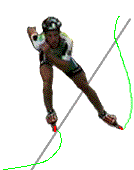


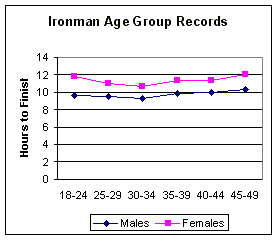
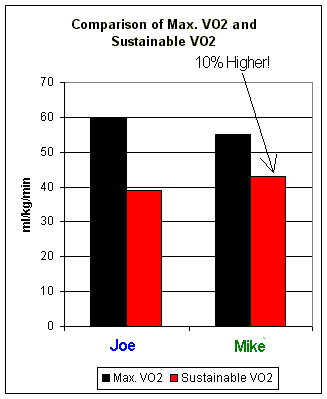
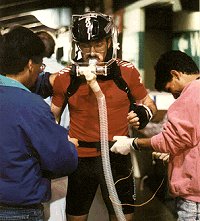 The
The 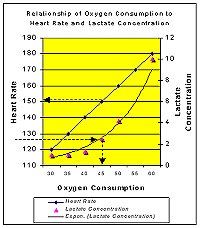
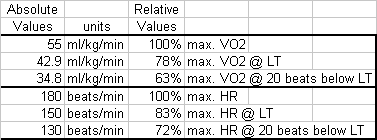
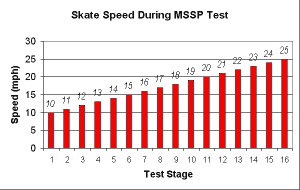 The test consists basically of the following: After a 10-minute
easy warmup, you perform multiple, consecutive 2-minute stages
of skating at incrementally-increasing speeds (increasing 1-mph
per 2-minute stage). A reasonable speed at which to start the
test is 10 mph. You should continue skating; increasing your
pace by 1 mph per stage until you can no longer consistently
sustain your pace for an entire stage (see Graph). The entire
test should take 30 minutes or less for most skaters; of course
the duration of the test depends on the maximum speed you can
sustain.
The test consists basically of the following: After a 10-minute
easy warmup, you perform multiple, consecutive 2-minute stages
of skating at incrementally-increasing speeds (increasing 1-mph
per 2-minute stage). A reasonable speed at which to start the
test is 10 mph. You should continue skating; increasing your
pace by 1 mph per stage until you can no longer consistently
sustain your pace for an entire stage (see Graph). The entire
test should take 30 minutes or less for most skaters; of course
the duration of the test depends on the maximum speed you can
sustain. 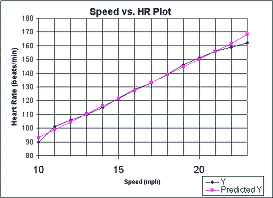 The physiology involved in this process is complex, but the
results are typically easy to understand: when your heart rate
reaches a certain point, your lactate level will increase to a
greater degree, therefore a simple graph of workload (speed)
versus heart rate will theoretically give you a fairly good
representation of your lactate level.
The physiology involved in this process is complex, but the
results are typically easy to understand: when your heart rate
reaches a certain point, your lactate level will increase to a
greater degree, therefore a simple graph of workload (speed)
versus heart rate will theoretically give you a fairly good
representation of your lactate level. 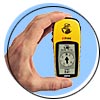 The pacing device I used is the Garmin eTrex personal navigator
(a small handheld GPS device).
The pacing device I used is the Garmin eTrex personal navigator
(a small handheld GPS device).
 The eTrex uses GPS technology (if you don't know what GPS is all
about, I suggest you either visit their
The eTrex uses GPS technology (if you don't know what GPS is all
about, I suggest you either visit their 
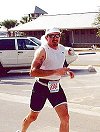 We weren't prepared for 2-3 hours of running, or 3 hours of
biking without increasing the risk of injury from overuse or
requiring significant recovery, so doubling up on workouts was a
good solution.
We weren't prepared for 2-3 hours of running, or 3 hours of
biking without increasing the risk of injury from overuse or
requiring significant recovery, so doubling up on workouts was a
good solution.  If you're not sure that you can accomplish your goal, it's not a
bad idea to set up a few "dry runs" before the event, to build
confidence and see what you'll have to contend with when you
actually attempt to reach your goal.
If you're not sure that you can accomplish your goal, it's not a
bad idea to set up a few "dry runs" before the event, to build
confidence and see what you'll have to contend with when you
actually attempt to reach your goal. 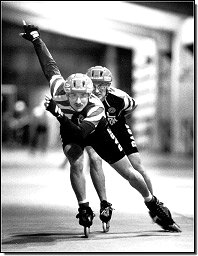 There is something to be said for listening to what your parents
taught you. Does the message, "If everyone else jumped off of a
bridge, would you follow them" sound familiar? Sometimes the
most common sense truisms really do work.
There is something to be said for listening to what your parents
taught you. Does the message, "If everyone else jumped off of a
bridge, would you follow them" sound familiar? Sometimes the
most common sense truisms really do work. 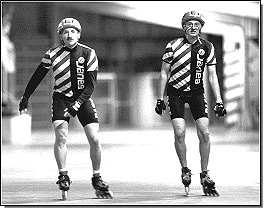 As a backup, I always like to have the option of an external
motivator. Most often, it's a training partner, spouse or friend
who is interested in your progress. It makes things much easier
on those "hard to get out of bed at 5 a.m. to skate" days.
As a backup, I always like to have the option of an external
motivator. Most often, it's a training partner, spouse or friend
who is interested in your progress. It makes things much easier
on those "hard to get out of bed at 5 a.m. to skate" days.